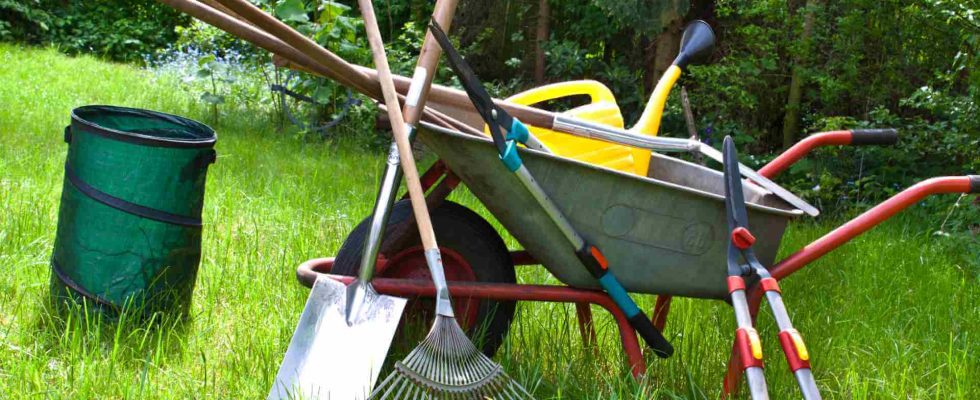What “home” for your tools?
The back of the garage
The back of the garage is the most used place. But between the bikes, the games, the leisure equipment, the laundry area, the DIY tools, the house maintenance equipment and the car, it quickly becomes a mess…
The lean-to or outbuilding
Every gardener’s dream! The available space allows this or that area to be dedicated to a specific activity, which avoids mixing up tools.
The shelter

Most often made of wood, easy to maintain, it is also available in iron or plastic, and in many sizes. Allow at least 2.50 m2 to accommodate a mower without taking up all the space.
The wardrobe
A good solution for smaller gardens, but also for terraces and balconies. It takes up little space on the ground, and allows the storage of hand tools and small equipment, fewer of which than in a garden.
Chest
Low in height, it can be placed under a window for example, to save space. It requires having tools with fairly short handles. Moreover, storage is done horizontally and by superposition, which is not always convenient. Some models also open on the front for easier access and storage.
Essential accessories
Rack
For long-handled, bulky tools. It makes it easier to store and use tools (each has its place), but takes up space on the wall. Models intended for tools interchangeable handles optimize space by providing locations for irons and shafts.
Long double crochets (about ten centimeters long)
To store iron tools at the top. Depending on the size of each person (spade or rake), it is possible to install 3 to 6. This system optimizes the space on the wall, but requires the gardener to remove one or more tools to access the one he needs.
Floor-mounted tool holders
Good formula if you have space. Accessible from all sides, they are installed in the middle of the shelter or under an awning. Models with shelves and drawers can be placed against a wall.
Small hooks
To accommodate pruning shears, transplanters, pruning saws, weeding knives, etc. The ideal is to attach them to a grid or perforated plate which ensures more freedom and better optimization of the surface (on sale in the DIY section).
Big hooks
Firmly fixed to the wall of the shelter (be careful of the fragility of the walls of metal or plastic models), they accommodate the wheelbarrow, but also the electric or battery lawn mower
Leave gasoline engine mowers flat to avoid fuel overflows, unless the tank mouth location is suitable.
Double crochet
To store the handle brush cutter by holding it by the base of its engine, but also the edger or even the hedge trimmer if the spacing is sufficient (in this case, the end of the blades must be closest to the ground to avoid accidents; however, you can also use the blade protection case by attaching it to the wall).
Wall dispenser

For accommodate garden hose and terminals. The sprinklers can be hung on a nail, just like the watering can, while the connectors and other small accessories will find a place in a drawer where they are unlikely to get lost.
High shelf
It is perfect for storing sprayers and fertilizers.
Lockable cabinet
Essential for storing treatment products, whatever they may be.
Plastic crate and drawers
To store protective glasses and gloves, but also very small equipment: pruning shears, grafters, grass shears, pruning hooks.
Coat hook
Welcome to keep dry apron, jacket or sleeveless vest.
Two pieces of an old broom handle or rake attached to a wide board make excellent (and economical) supports for your boots.
Essential cleaning
- Agricultural tools : After each use, rub them with newspaper then a brush. Before winter, coat the iron with paraffin, kerosene or oil to protect it from rust. Regularly rub the wooden handle with very fine sandpaper to eliminate any risk of splinters, then soften it with paraffin for a more pleasant contact.
Handled tools are stored head up.
- Blade tools : Eliminate any remaining sap by rubbing the blades with a cloth soaked in methylated spirits. Put a drop of oil on the joint and check the sharpness. Grind it if necessary using a sharpening stone.
- Mower: Clean the inside of the deck to remove any stuck grass blades. You will thus maintain all the collection qualities of your machine and you will avoid corrosion problems.
- Sprayer : After each application of phytosanitary product, eliminate the excess in a hole dug in a flowerbed and rinse the tank thoroughly. Fill it with clean water and spray to clean the lance and nozzle. Store the appliances with the tank open to avoid any condensation.

